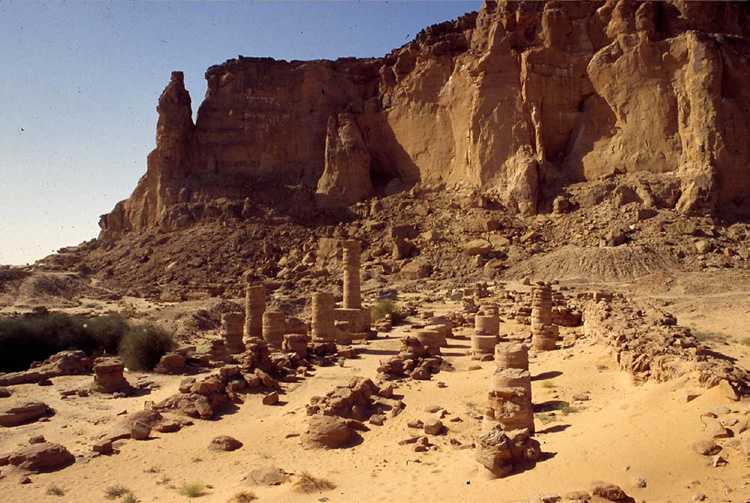Although the Kushite kings of the 25th Dynasty ruled over both Egypt and Nubia, their political center was at Napata, downstream from the Fourth Cataract. The most prominent physical feature of the ancient city of Napata is the sandstone outcrop known as Gebel Barkal, its steep cliffs rising over 100 meters above the plain. When Egypt controlled Upper Nubia in the New Kingdom the mountain was believed to be sacred - the chief Nubian residence of their god Amen. This was where Thutmose III erected a temple that was later enlarged in the 19th Dynasty. Although the origins of the later Kushite state are unknown, by the 9th/8th centuries Bc, Napata was the center of this indigenous polity, whose state religion focused on

Figure 9.4 View of temples at the base of Gebel Barkal. Source: © Timothy Kendall.
The Amen cult there. of great symbolic importance to the Kushite kingship, the Napatan cults of Amen of Karnak and Amen of napata were believed to confer legitimacy upon the king. Extending to the east from the base of Gebel Barkal a number of temples and a palace complex were built by the 25th-Dynasty kings and their successors (Figure 9.4).
The first major excavations at Napata were by George Reisner (1916-1920) and understanding of the sequence of temple construction is based on his work. In the early 8th century Bc a mud-brick temple with stone columns (B 800-sub in Reisner’s numbering system) was built there, probably by a Kushite king named Alara. His successor Kashta, who began the conquest of Egypt, extended this temple in stone and built an adjacent palace. Kashta’s son Piy restored the 18th/19th-Dynasty temple (B 500) at Napata, which was over 150 meters long, and rebuilt temple B 800 in stone. Piy also restored the large hypostyle hall that had been added onto the 18th-Dynasty temple by Sety I and Rameses II. King Taharqo, who also left a number of temple monuments in Egypt, built two temples at Napata (B 200 and B 300). The last king of the 25th Dynasty, Tanutamani, built a kiosk structure inside temple B 500.
The Napatan temples were designed in the style of Egyptian ones, with a series of pylons, an outer court, hypostyle hall, pronaos, and inner sanctuary (naos) and chapels. The continued importance of the state cult of Amen, which was introduced into upper Nubia in the New Kingdom, probably helped to reinforce the role of Kushite kings there. The Kushites spoke an indigenous language (Meroitic), for which they did not yet have a writing system, and inscriptions on the Napatan temples (and in tombs) are in Egyptian hieroglyphs.
After the 25th Dynasty Kushite kings continued to build at Napata, and restoration took place after the site was pillaged and burned - most likely by an invasion of the army of the Saite king Psamtek II. At the site of dokki Gel, to the north of Kerma, archaeologists of the university of Geneva mission have found fragments of seven monumental statues of Kushite kings that were ritually buried after Psamtek’s invasion.
Later, when Meroe became the seat of the Kushite rulers, temple restoration and construction continued at Napata, and new palaces were also erected there - due, no doubt, to Napata’s cultic importance. While the earlier temples were built in an arc at the base of Gebel Barkal, the latest ones and a large palace complex were erected in an area to the northeast of the gebel.
Much archaeological work remains to be done at Napata. Timothy Kendall resumed Reisner’s work there late in the 20th century, and Italian and Spanish archaeologists have also been excavating there. An exciting find occurred in 1987, when, with the help of an American rock climber, Kendall scaled a pinnacle separated from the main gebel, where he copied an inscription of Taharqo, first seen with binoculars. The inscription was originally covered with gold sheeting.
Archaeological investigations at Napata have focused on the monuments there - the temples and palaces, and tombs to the west of the gebel. Thus the evidence suggests that Napata was a cult center with royal residences (that may also have had administrative functions). But the plan of the city remains unknown - as are any domestic quarters for its non-elite and industrial areas where its artisans and craftsmen would have worked.
Across the river from Napata is the site of Sanam, at the end of the track/road that crossed the Bayuda Desert from Meroe farther upstream - a much shorter route than the trip by boat downstream. Sanam was excavated by an Oxford University expedition in 1912-1913, led by Francis Llewellyn Griffith. A large Amen temple was located at this site, where there was also evidence of craft workshops for shawabtis and other small artifacts. In the desert to the east of the temple Griffith excavated what he called the “treasury,” a columned building over 250 meters long with 17 storerooms to either side of a central corridor. Artifacts with cartouches of Kushite kings (Piy to Aspelta) date the structure from the 25th Dynasty to the mid-6th century Bc. In both the Sanam temple and “treasury” there is evidence of large-scale burning. Piles of ivory tusks were found in one room of the “treasury,” and this structure may have been a kind of warehouse for the exotic raw materials imported through Nubia from regions to the east of the Nile - a major source of state wealth.
Over 1,500 burials of different types/statuses were also excavated at Sanam. Possibly the Egyptian-style burials there, in subterranean chambers entered by staircases, with mummified remains in coffins and Egyptian grave goods and wheel-made pottery, belonged to Egyptians (and Egyptianized Nubians?) employed as bureaucrats and artisans by the Kushite kings. Another type of burial at Sanam, of extended bodies in rectangular pits accompanied by wheel-made pots, may represent a lower-status Egyptianized group. The simplest burials, of contracted bodies with both wheel-made and hand-made pottery, and multiple burials with no grave goods, may be graves of the non-elite majority of the Napatan population who worked there and were buried at a different location from the Napatan royal cemeteries. While Napata may have been the center of the state religion and the royal seat where the accession took place, Sanam may have functioned as an important economic (and industrial?) center.




 World History
World History









